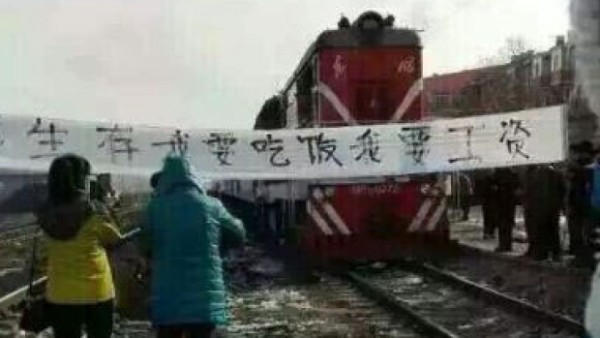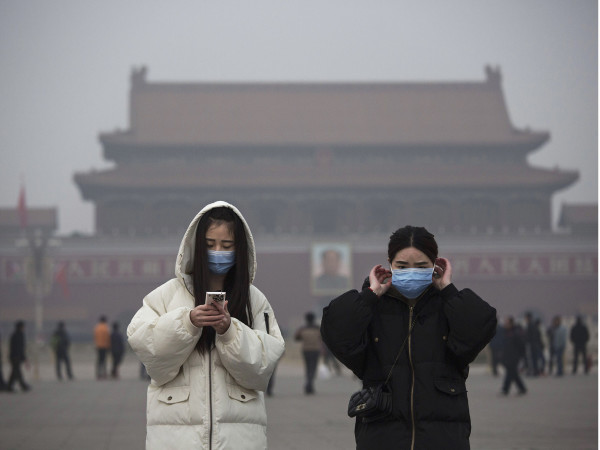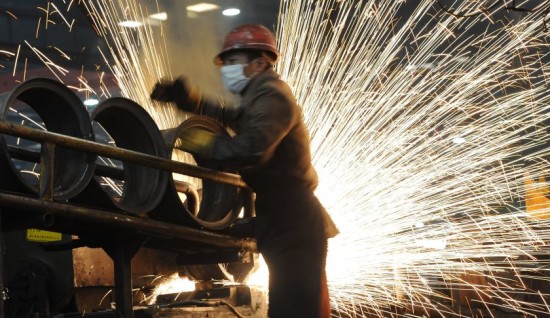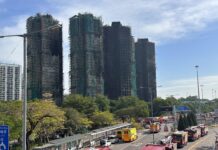China’s rulers are destroying ten times as many coal mining jobs as Britain’s ‘Iron Lady’ Mrs Thatcher
chinaworker.info reporters
A tsunami of job destruction is heading towards heavy industry in China. This is especially in the coal and steel sectors which suffer from a flooded market and falling prices. Coal prices have fallen by 50 percent since 2012, pulled down by the slump in China’s housing construction which was the main driver of global demand. Coal and steel output in China have both fallen by 6 percent in the first two months of 2016, a faster rate of contraction than in the past two years.
The wave of job cutbacks – part of Xi Jinping’s ‘supply-side reforms’ – is the most important policy signal to come from the National People’s Congress (NPC) in March. “China just announced one of the largest single layoffs in history,” ran a headline on business website Quartz.
Premier Li Keqiang left no doubt on this score when he said during his live televised press conference at the end of the NPC: “We’ve already chosen steel and coal as the two sectors for achieving initial breakthroughs in reducing production capacity.” Li was speaking just days after a huge strike by coal miners in Shuangyashan, Heilongjiang province, which the premier and other officials of course never mentioned. Li ignored a journalist who shouted out an unscripted question about what would happen to workers who lose their jobs.
While the CCP (so-called Communist Party) dictatorship is being coy about the scale of the coming redundancies, a widely cited Reuters report based on anonymous government sources says 5-6 million job cuts are planned over the next three to four years. This will shrink the state sector workforce to 31 million from 37 million workers in 2013 – a 17 percent reduction. Of these, 1.3 million jobs will be axed in coal production and 500,000 in steel. There are fears that these cuts could just be the tip of the iceberg.

2.2 million coal jobs to be axed
For the workers in industrial regions like China’s northeast the hard landing has already arrived. “The pain is spreading among workers, companies and local governments nationwide,” noted Caixin magazine, which is an enthusiastic supporter of the job cuts and the CCP’s supply-side economics.
The ‘Iron Lady’ Margaret Thatcher declared war on the British mineworkers in the 1980s. Under her viciously anti-working class rule and that of her successor, John Major, over 190,000 jobs were eliminated in the country’s coal sector. But in China’s case, ten times as many coal industry workers will lose their jobs. And rather than decades this is planned within the space of a few years. Official data shows that 890,000 coal jobs have already been lost in China since the end of 2012, which together with the 1.3 million recently announced by Yin Weimin, the Minister of Human Resources and Social Security, brings the total job reduction in the coal sector to around 2.2 million.
To offer another comparison, the great downsizing of the US steel industry in the 1980s and ‘90s saw the number of jobs fall from 450,000 to just 150,000 workers. This is dwarfed by Beijing’s plans to eliminate 500,000 steel job in the next three to four years.
Workers are fighting back
The strike by coal miners in Heilongjiang during the annual NPC session is one of most important developments since Xi Jinping came to power. The workers’ determined struggle forced the provincial officials to make funds available to crisis company Longmay Group for it to begin paying the workers’ unpaid salaries. Unfortunately, without further mass pressure and organised struggle to change how the economic system is run, the Longmay workers and millions of others will inevitably be cheated again in the months and years ahead.
At the same time as the Longmay workers in Shuangyashan took their protests to the streets there were strikes by steel and coal industry workers in Jilin and Shanxi. The situation in provinces and regions that depend on heavy industry is becoming explosive. Workers from Shuangyashan who spoke to chinaworker.info say many families are going hungry because they cannot afford to buy food.
Longmay Group, owned by the Heilongjiang provincial government, is the biggest coal company in northeast China. Its workforce of 250,000 is greater than the entire coal mining workforce of the 28-country European Union. Last September Longmay announced that 100,000 jobs would go because it is saddled with big debts and a shrinking market.
Longmay faces pressure to repay the interest on its loans and has prioritised these payments at the expense of paying wages to its workforce, many of whom are at semi-closed pits or pits working only at half-speed.
This process shows the same dynamic as in other countries where the banks, which were a major cause of the great economic meltdown and recession of 2008, are at the front of the queue to demand their ‘pound of flesh’ in the form of government bailouts. Many of the world’s biggest banks have been saved from collapse with vast sums of public money while ordinary workers have suffered falling incomes, unemployment, cuts in pensions and other harsh forms of austerity.
READ: Mineworkers’ protests shake China’s leaders
Bailouts for banks, austerity for the masses
A shocking example is Greece, where the government has been forced to pay billions of dollars in interest repayments to German and French banks. Under the pressure of the banks and international agencies such as the IMF and EU the Greek government has been stealing this money from the working class, public sector employees and pensioners.
In China there is no IMF bearing directly down on the government or upon indebted companies like Longmay, but the CCP regime follows the same market logic and imposes its own austerity demands on provinces like Heilongjiang. The relationship is quite similar to Greece – with Beijing and the Finance Ministry playing the role of the IMF/EU loan sharks.
Socialists completely reject such economic arguments. We say the debts should be written off. These debts were created by the wasteful, greedy, and unrealistic schemes of unelected officials and company directors spurred on by the central CCP leaders with their fixation on GDP growth at all costs. Workers should not be made to pay for this crisis. We demand that the banks, whose reckless lending and profit greed encouraged companies like Longmay to dig themselves into debt, should be placed under the democratic control of the working class. Their financial accounts and the accounts of any company that threatens to cut jobs should be opened to public inspection by the working class to see how the money has been spent.
The directors, financiers and government officials responsible for creating this mess should be dismissed and punished. They should be replaced not by more profiteers and corrupt officials but by a democratic workers’ administration elected from below. The workers’ protests should raise the key demand of no layoffs – work or full pay! If democratic planning is adopted to replace the ‘market’ fundamentalism of Xi Jinping and the CCP regime, every job could be secured as part of a total industrial re-organisation to develop potentially huge new sectors in renewable energy and refitting the economy on a carbon-free and anti-pollution basis.
This would entail cleaning up the 70 percent of China’s rivers and waterways which are now toxic, and re-fitting millions of homes and cities with modern energy-efficient central heating systems powered by renewable energy, to cite just two examples. This could create millions of new jobs. But such a vast economic transition is beyond the scope of a market-based model. It could only be realised as part of a democratic socialist plan, which in turn would require a revolutionary challenge to the power of the billionaire vested interests that the CCP regime protects.

Resettlement fund
The government promises a resettlement fund to compensate dismissed workers. They talk about retraining and ‘alternative growth engines’ as well as a ‘gradual’ approach based on merging and consolidating existing coal and steel companies. But how much trust can be placed in such vague statements?
Longmay Group was itself formed by merging four state-owned companies in 2004 – clearly this has not saved jobs! The main economic ‘solution’ put forward by the government is increased consumer spending, but this is nowhere on the horizon. How can consumer-driven economies take root in regions like Heilongjiang with mass unemployment and hundreds of thousands not receiving their wages or pensions?
Already officials from different provinces are fighting over who will get a piece of Li Keqiang’s resettlement fund. Speaking at the NPC, Gao Hongzhi, the CCP chief of Handan in Hebei province, urged Beijing not to “spread the pepper” and instead to concentrate the special fund on… Hebei province!
At just 100 billion yuan the proposed fund is too small. Divided among the 1.8 million coal and steel workers already targeted for layoff, 100 billion yuan would only cover around 11 months’ salary. Conservative estimates say that ten times this amount – 1 trillion yuan – has been spent to rescue the stock market (not very successfully). This shows the regime’s skewed priorities.
What kind of ‘alternative’ jobs will be offered to laid-off coal and steel workers? If any jobs are offered this will be in low paying branches such as restaurants, transportation and retail. The ‘hi tech’ and ‘innovation’ sectors that the CCP leaders like to focus on in their speeches are only developing in small pockets around the country. But there is no guarantee that even the former will be available for laid off workers. “They haven’t told us anything about plans for other jobs,” complained a worker from Longmay’s coal mine in Jundeshan. “If just one official came to us to say something, that would be good, but there hasn’t been any word.”
READ: Twin meetings, mass layoffs and failed reforms
What is supply-side economics?
The government has rebranded its economic reforms with the slogan ‘supply-side economics’. This slogan is inspired by the policies in the 1980s of Mrs Thatcher in Britain and her ideological ally President Reagan in the US. Both had a mission to increase the profits of the capitalists by attacking the working class and “taking a knife” to the public sector – a term that Li Keqiang also likes to use.
Privatisation, reducing government regulation, increased unemployment, tax cuts for big companies – these were the hallmarks of supply-side economics in the West. China’s leaders may not follow the same policies in every detail. Thatcher and Reagan attacked and shackled the trade unions, but in China this job is already done: independent unions in which the members decide matters through democratic votes are banned in China.
Within the CCP elite there is an admiration for Thatcher and Reagan as uncompromising ‘reformers’ who did not step back or soften in pursuing painful economic restructuring. Jia Kang, an economist in the Ministry of Finance, spelt this out in comments made to the New York Times (3 March 2016): “Thatcher and Reagan are highly regarded because it was proven that they made the right choices under heavy pressure. Their spirit was one of boldly taking on challenges and innovating, and that’s certainly worth Chinese people emulating.”
In the past year especially, the CCP regime has imprisoned many dissidents for allegedly harbouring “Western values”. Yet there is no bigger fan club for the “Western values” of the Thatcherite and Reaganite economists than the Ministry of Finance in Beijing. Among workers and youth in Britain and America, Thatcher and Reagan are widely hated. The results of their policies were to make the rich richer and the poor poorer – a model that has been copied all around the world in the decades since.
Regions devastated – still to this day
Many of the towns and regions in Western countries that were devastated by supply-side economics and the mass closure of heavy industry in the 1980s and ‘90s are still suffering from the economic and social effects.
“Even developed countries are having trouble increasing service sector jobs in regions that lost mining and manufacturing jobs 20 to 30 years ago,” says East Asian economic expert Ramon Pacheco Pardo from King’s College London.
These policies have in some cases led to a strong regional or national consciousness developing against central governments that are blamed for the destruction of local economies. This is the case in Scotland, which two years ago came very close to voting for independence from Britain. Similar moods have developed in Eastern Germany and Catalonia in Spain. China could be affected in similar ways as its economic crisis continues, with an upsurge in demands for local autonomy or even independence.
As we have warned on chinaworker.info the capitalist reform policies of Xi Jinping and the CCP leadership represent a road to disaster. If fully implemented these policies could result in an economic slump – a hard landing – with the collapse of many industries and companies and not only the so-called ‘zombie’ companies.
This is already happening in regions like the northeast but it is also true of other regions. Speaking about the Pearl River Delta in Guangdong – known as ‘the world’s factory’ – a top economist at HSBC, John Zhu, warned: “What’s happening now is you are reaching a stage where even healthy industries, or companies that would normally be profitable, are running into stress. It’s actually quite an urgent situation…” (Globe and Mail, Canada, 2 February 2016).
chinaworker.info stands for:
- No job cuts – work or full pay!
- Fight back against the CCP regime’s “Western values” of Thatcherite supply-side economics!
- Open the books of any company threatening layoffs to public and workers’ inspection!
- Workers – prepare to form independent unions starting with underground organisations. For mass strikes to win, independent unions are essential!
- For democratic workers’ control and management of major companies, the banks and financial sector. Cancel the debts of state-owned companies. Dismiss and send the corrupt managers, bankers and officials to trial!
- For a democratic plan for the economy to prioritise new sectors in clean energy and repairing the ecological devastation of CCP policies!





